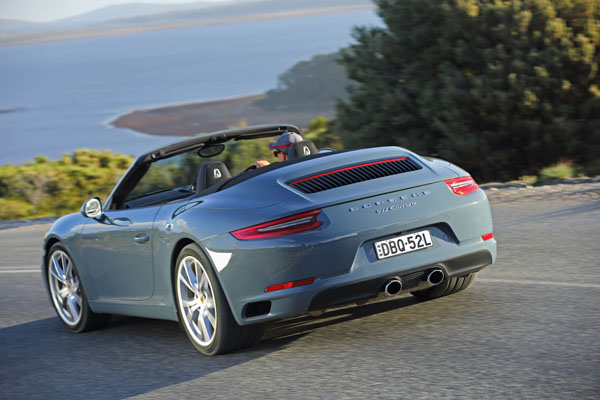

It is almost 20 since Porsche purists raised their Pilseners all over the world and sadly declared that the Porsche 911 was dead. Killed by emissions ratings meant that cooling the flat-six engine purely by airflow was no longer possible. The finer control that water cooling offered meant that, despite attempts to the contrary by desperate engineers, water replaced air around the Porsche powerplant.
Porsche engineers are smart guys and gals and switched their brains into lateral thinking mode. Realising that what the purists most wanted was the sound of the engine, they were able to produce a water cooled unit that didn’t sound all that much different to the air cooled one.
The 911 lived on.
The same engineers, perhaps with some of their sons and daughters beside them, have been faced with even tougher emission controls ever since. As with the other Euro marques, Porsche came to the realisation that smaller engines with turbochargers were the only way to go to keep engines legal.
The biggest trouble with turbo engines is lag – the time it takes for the boost to build up after you hit the pedal on the right. Porsche has come up with a 3.0-litre flat-six with twin turbochargers, so the downsizing hasn’t been as extreme as with other makers’.
Some impressive new features were added to keep lag to a minimum, with the incoming air being electronically managed in different ways according to driver’s need, and road and climatic conditions. The engine gets its air centrally in front of the rear spoiler. The air flows from two other ports into two induction channels that lead to the turbochargers. The turbochargers compress and the air which then flows through two intercoolers behind the wheel arches and then into the engine’s induction manifold via the throttle flap.
That’s the good news, the bad news is the same as that which has saddened owners of Porsche Boxsters for years. The 911’s engine is completely hidden.
With the engines in different states of tune, power outputs are 272 kW in the 911 Carrera and 309 kW in the 911 Carrera S. Big torque is the biggest advantage of turbocharging and the engines have 450 and 500 Nm, respectively. This peak torque is achieved at a ridiculously low 1700 rpm so there bulk grunt on offer virtually all the time.
Performance from zero to 100 km/h in the 911 Carrera coupe Porsche PDK automatic is just 4.2 seconds if the Sport Chrono Package is specified. The big power Carrera S does it in just 3.9 seconds. This is the first 911 Carrera to break into the three second bracket.
Choose the Sport Chrono Package the 911 Carrera gets a mode switch, mounted on the steering wheel. it gives the choice of “Normal”, “Sport”, “Sport Plus” and “Individual”. The Individual setting lets you configure PASM, active engine mounts, PDK shifting strategy and sports exhaust system.
When the PDK transmission is fitted, the mode switch has an additional push button in its centre. Porsche says it’s a “Sport Response Button”, and would rather we didn’t call it a “Push to Pass” – so we won’t. When this button is pressed, the drivetrain is pre-conditioned for maximum acceleration for 20 seconds.
The upgraded 911 has the latest Porsche Communication Management system (PCM) with a new touchscreen that lets you operate it almost as though it’s a smartphone. Porsche Car Connect (PCC) features include traffic information in real time, Google Earth and Google Street View. The system can be networked with a smartphone to give access to many apps.
On the roads in the countryside around Launceston in Tasmania we gave the latest Porsche 911 a thorough workout. We sampled the Carreras (standard and S) in both PDK and seven-speed manual format, as well as with coupe and convertible bodies.
It’s hard to imagine that significant gains over the just superseded 911 are possible but Porsche has achieved just that. The new engines have tremendous urge and even without engaging the SRB system there’s very little turbo lag. Hit SRB to prepared for added urge and the German sportscar is simply brilliant in the way it brings smiles to faces.
Porsche’s aural engineers have been proving their worth since the days when they switched from air to liquid cooling and the latest 911 produces all the right noises, some of them artificially achieved in areas like the spitting and crackling on hard downchanges. But, hey, who cares, it’s the enjoyment that matters.
Handling is as tenacious as ever thanks to the taming of the rear-heavy layout. Obviously it will bite in the end if you switch off the electronic aids and push it to silly levels. Sadly, time pressure left us unable to enjoy some hot laps at Symmons Plains racetrack that were on offer at the end of the day…
Then there’s the bad news, we have never heard so much road-roar from tyres on coarse road surfaces. Drive for long distances on Australian country roads and you may not be able to hear properly for some time afterwards. On smooth roads, such as those that are the norm in Europe it’s fine.
Porsche’s 911 is now in its 54th year and with each new model continues to set high standards that appeal to the keenest of drivers – yet does so at prices that are relatively modest for the performance and prestige it provides. The list starts at $271,800 for the Carrera Coupe.
Prices of the complete Carrera and Carrera S range are:
Carerra Coupe: $217,800
Carrera S Coupe: $252,800
Carrera Cabriolet: $239,300
Carrera S Cabriolet: $274,300
Carrera 4 Coupe: $233,900
Carrera 4S Coupe: $269,000
Carrera 4 Cabriolet: $255,400
Carrera 4S Cabriolet: $290,500
Note: These prices do not include government or dealer delivery charges. Contact your local Porsche dealer for driveaway prices.











